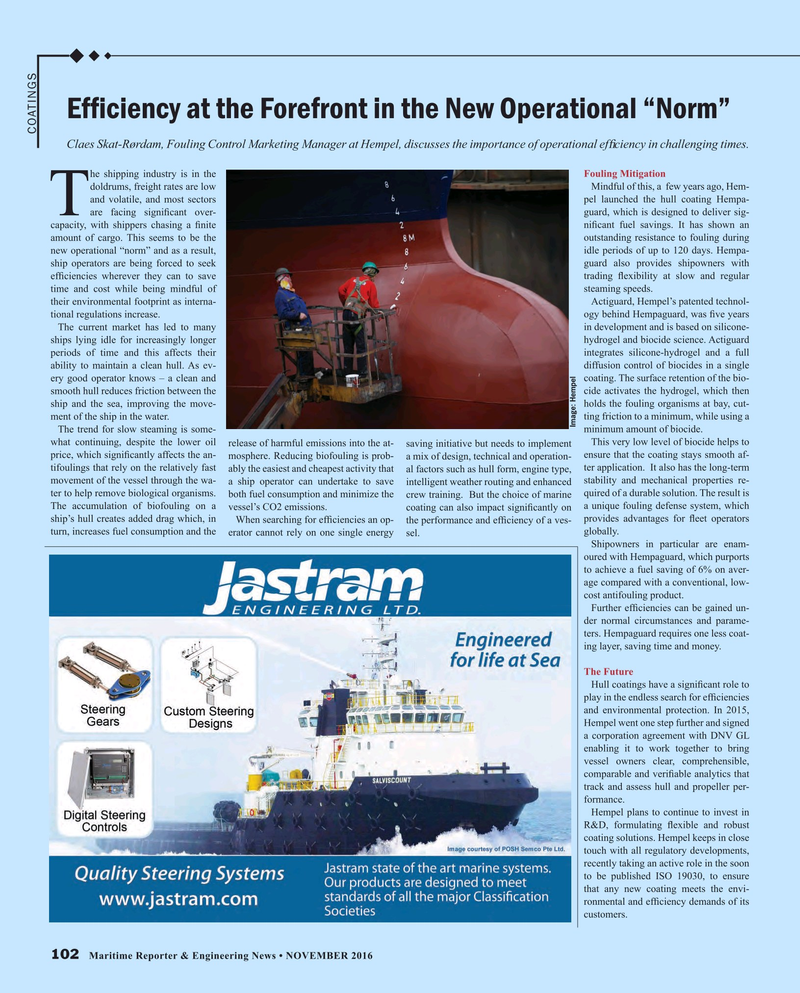
Page 102: of Maritime Reporter Magazine (November 2016)
Workboat Edition
Read this page in Pdf, Flash or Html5 edition of November 2016 Maritime Reporter Magazine
Ef? ciency at the Forefront in the New Operational “Norm”
COATINGS
Claes Skat-Rørdam, Fouling Control Marketing Manager at Hempel, discusses the importance of operational ef? ciency in challenging times.
he shipping industry is in the Fouling Mitigation doldrums, freight rates are low Mindful of this, a few years ago, Hem- and volatile, and most sectors pel launched the hull coating Hempa-
Tare facing signi? cant over- guard, which is designed to deliver sig- capacity, with shippers chasing a ? nite ni? cant fuel savings. It has shown an amount of cargo. This seems to be the outstanding resistance to fouling during new operational “norm” and as a result, idle periods of up to 120 days. Hempa- ship operators are being forced to seek guard also provides shipowners with ef? ciencies wherever they can to save trading ? exibility at slow and regular time and cost while being mindful of steaming speeds. their environmental footprint as interna- Actiguard, Hempel’s patented technol- tional regulations increase. ogy behind Hempaguard, was ? ve years
The current market has led to many in development and is based on silicone- ships lying idle for increasingly longer hydrogel and biocide science. Actiguard periods of time and this affects their integrates silicone-hydrogel and a full ability to maintain a clean hull. As ev- diffusion control of biocides in a single ery good operator knows – a clean and coating. The surface retention of the bio- smooth hull reduces friction between the cide activates the hydrogel, which then ship and the sea, improving the move- holds the fouling organisms at bay, cut- ment of the ship in the water. ting friction to a minimum, while using a
Image: Hempel
The trend for slow steaming is some- minimum amount of biocide.
This very low level of biocide helps to what continuing, despite the lower oil release of harmful emissions into the at- saving initiative but needs to implement price, which signi? cantly affects the an- ensure that the coating stays smooth af- mosphere. Reducing biofouling is prob- a mix of design, technical and operation- tifoulings that rely on the relatively fast ably the easiest and cheapest activity that al factors such as hull form, engine type, ter application. It also has the long-term movement of the vessel through the wa- a ship operator can undertake to save intelligent weather routing and enhanced stability and mechanical properties re- ter to help remove biological organisms. both fuel consumption and minimize the crew training. But the choice of marine quired of a durable solution. The result is
The accumulation of biofouling on a vessel’s CO2 emissions. coating can also impact signi? cantly on a unique fouling defense system, which ship’s hull creates added drag which, in provides advantages for ? eet operators
When searching for ef? ciencies an op- the performance and ef? ciency of a ves- globally.
turn, increases fuel consumption and the erator cannot rely on one single energy sel.
Shipowners in particular are enam- oured with Hempaguard, which purports to achieve a fuel saving of 6% on aver- age compared with a conventional, low- cost antifouling product.
Further ef? ciencies can be gained un- der normal circumstances and parame- ters. Hempaguard requires one less coat- ing layer, saving time and money.
The Future
Hull coatings have a signi? cant role to play in the endless search for ef? ciencies and environmental protection. In 2015,
Hempel went one step further and signed a corporation agreement with DNV GL enabling it to work together to bring vessel owners clear, comprehensible, comparable and veri? able analytics that track and assess hull and propeller per- formance.
Hempel plans to continue to invest in
R&D, formulating ? exible and robust coating solutions. Hempel keeps in close touch with all regulatory developments, recently taking an active role in the soon to be published ISO 19030, to ensure that any new coating meets the envi- ronmental and ef? ciency demands of its customers. 102 Maritime Reporter & Engineering News • NOVEMBER 2016
MR #11 (98-105).indd 102 11/4/2016 1:47:37 PM

 101
101

 103
103
